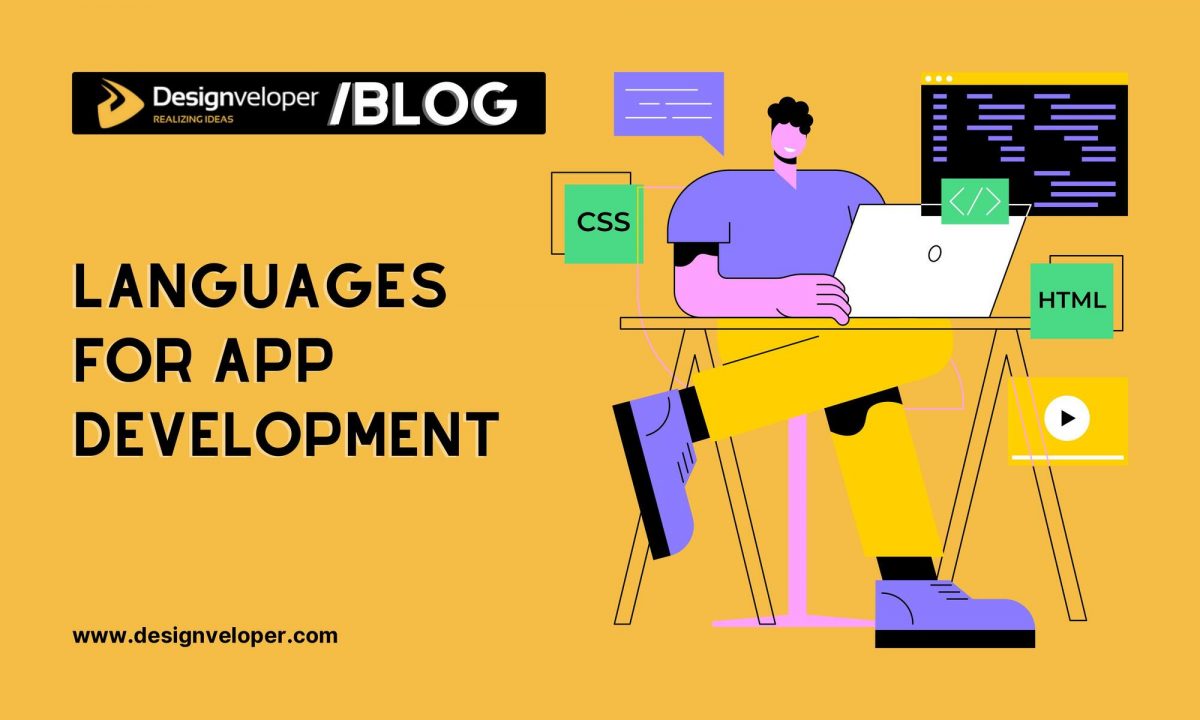Picture this: You’ve invested your passion and creativity into an innovative app idea, dreaming of millions eagerly clicking “download.” The concept seems promising, but a vital question remains: Does your mobile app idea align with your audience’s needs? Don’t dive into development without clarity on this. Understand your potential users’ desires first. This is where mobile app market research becomes indispensable.
If you crave a thorough guide to embark on mobile app market research, keep reading this article. This guide will enlighten you about the advantages of market research for app development, the significance of choosing the right platforms for your apps, and the latest technologies in the field. Consider this guide your essential partner in mastering mobile app research. Let’s start this enlightening journey together!
Why Conduct Mobile App Market Research?
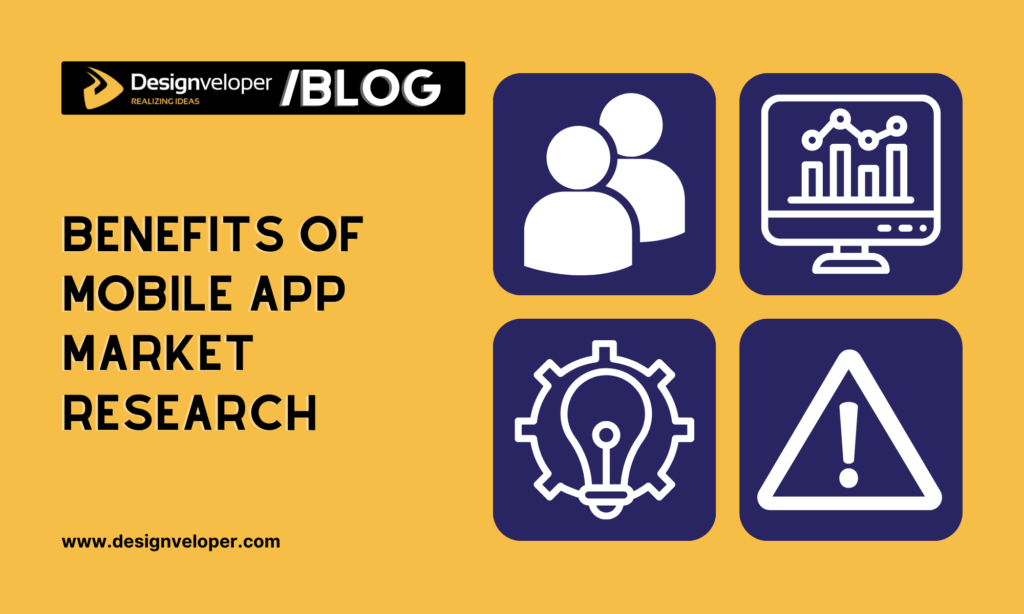
Market research is an integral contributor to your app success because it helps reveal what your users crave and what the market truly needs.
In other words, mobile app research helps answer these questions when you learn about your target audience and the market:
- Who are your ideal users? (Age, location, interests, or mobile usage habits)
- What are their needs and pain points? What problems do they face with existing apps?
- What features would they find most valuable? What would make their lives easier or more enjoyable?
- How much are they willing to pay for a solution? What are their spending habits and preferences?
- What platforms do they use most? iOS, Android, or something else?
By answering these questions and many more, you can unlock the following benefits of mobile app research:
Validate App Ideas
Research helps you identify if your app concept is a diamond or a lump of coal. This helps avoid pouring resources into ideas with low market potential and discover hidden gems that users will flock to.
Understand Your Target Audience
Ever tried designing a shirt without knowing your friend’s favorite color or style? It wouldn’t exactly be a hit, right? Similarly, building an app without understanding your target audience is a recipe for disaster. Research paints a vivid picture of your ideal users – their demographics, tech savviness, mobile habits, and even their deepest pain points. This empathy-driven approach ensures your app speaks their language and solves their problems seamlessly.
Analyze Competition
The mobile app landscape is a competitive battlefield, but knowledge is your ultimate weapon. Research unveils the strengths and weaknesses of your competitors, allowing you to learn from the best and carve your unique path. Besides, you can identify untapped market segments, avoid their pitfalls, and create an app so unique and compelling that it leaves them in the dust.
Reduce Risk
Mobile app research serves as a magic shield against costly mistakes. By making informed decisions about features, platforms, and monetization strategies based on real data, you minimize the risk of wasted resources and development dead ends. This ensures your app is set on a path to sustainable success.
A 6-Step Guide to Powerful Mobile App Research
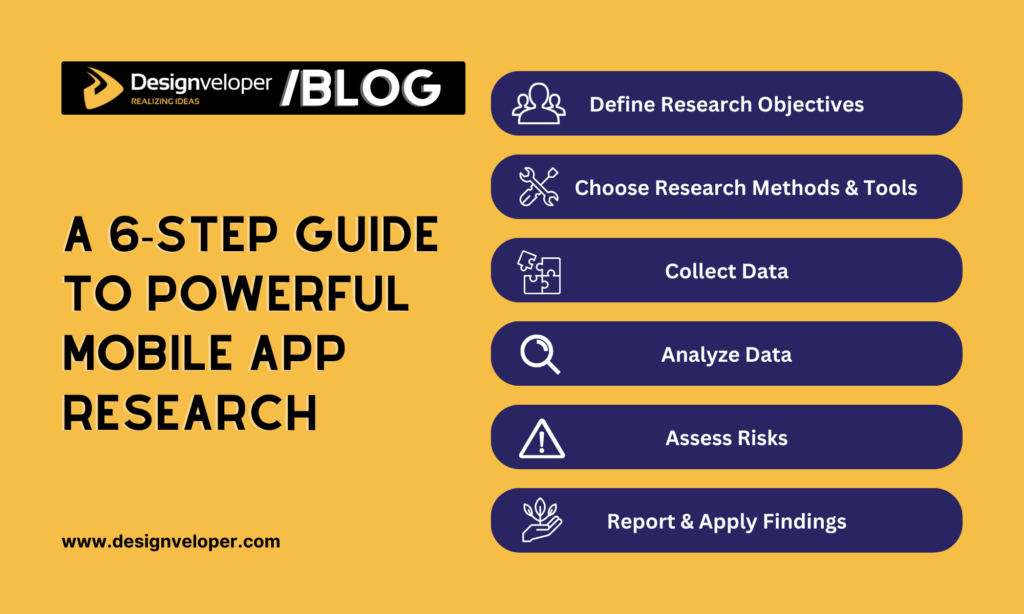
You’ve learned about the importance of market research for your mobile apps. So now, let’s navigate the six actionable steps to conduct mobile app research effectively.
Step 1: Define Your Research Objectives and Questions
Defining your research objectives and questions is the foundation upon which successful mobile app research is built. This step is crucial as it sets the direction for your entire research process. It helps you to focus on what you want to learn and the specific questions you want to answer.
Ask yourself the following questions to help identify your research objectives:
- How big is the market for my app idea?
- Who are my competitors, and what are their strengths and weaknesses? Can I identify gaps in their offerings or capitalize on their blind spots?
- What are the top frustrations my potential users face in similar apps?
- What features do users value most?
- What pricing model would be most profitable?
By answering these questions, you can formulate clear and concise research objectives. For this reason, you can avoid wasting time and resources on searching irrelevant or unnecessary information. Furthermore, having clear research objectives and questions can help guide your data collection and analysis, ensuring that your research findings are relevant and actionable.
Step 2: Choose Your Research Methods and Tools
Now that you’ve charted your course with clear research objectives, it’s time to grab suitable methods and tools for your research. This step determines how you will collect and analyze the data needed to answer your research questions. Accordingly, choosing the right methods and tools helps you target your research data and increase the reliability of your findings.
There are two main types of research methods you can use: primary research and secondary research.
Primary research involves collecting new data that has not been collected before. For example, surveys, interviews, and observations are all types of primary research. You can use online survey tools, such as SurveyMonkey or Google Forms, to create and distribute surveys to your target audience.
Secondary research, on the other hand, involves using existing data that has been collected by someone else. This can include reports, market research studies, and articles. You can use web search tools, such as Google Trends, Statista, or Pew Research, to find relevant and trustworthy sources of secondary data.
Depending on your objectives and questions, you can use different methods and tools to collect and analyze data. For instance, if you want to understand the size and growth of your market, you might use secondary research to find existing reports and studies. If you want to understand the pain points of your customers, you might use primary research to conduct surveys or interviews.
Step 3: Collect and Organize Your Data
With your research tools in hand, it’s time to embark on excavating your data for mobile app research, by both qualitative and quantitative methods. When collecting data, you should consider various aspects of your target market. These include:
- Demographics: Age, location, income, and education – these basic details paint a picture of your target audience.
- Psychographics: Values, interests, and lifestyle choices offer deeper insights into user motivations and aspirations.
- Online behavior: Web browsing habits, social media engagement, and even app usage patterns reveal valuable clues about user preferences.
- Mobile app usage habits: How do users interact with apps? What features do they value? Or how often do they use them? These questions help you better understand app usage patterns. Such information is essential for creating an engaging and user-friendly experience later.
After you have collected data, it’s important to record and organize your data in a clear and consistent way. This could involve using spreadsheets, charts, or tables to keep track of your data. Tools like Microsoft Excel or Google Sheets can be particularly helpful for data management and visualization.
Organizing your data effectively can make the subsequent steps of analyzing and interpreting your data much easier. It can help you to see patterns and trends in your data, and it can make it easier to share your findings with others.
Step 4: Analyze and Interpret Your Data
Once you have collected and organized your data, you can start analyzing and interpreting it to find patterns, insights, and answers to your research questions.
But in the age of data, caution is key. The 2021 Report by Remesh revealed that 56% of agencies are becoming more cautious about how they receive and analyze data. This underscores the importance of responsible data handling in mobile app research.
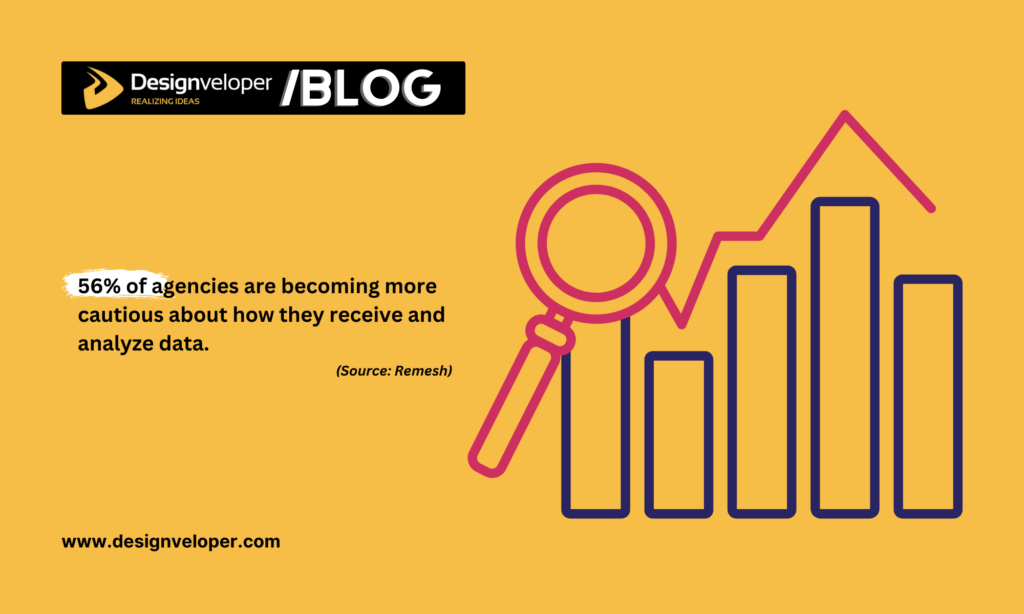
Data analysis involves looking at your data from different angles and having in-depth insights into these aspects:
- Existing apps in your niche: Understand the landscape, their strengths, weaknesses, and feature sets. This helps you avoid reinventing the wheel and carve out your unique space.
- Market trends and user insights: Stay ahead of the curve by identifying emerging technologies, user behavior shifts, and evolving market demands. This ensures your app remains relevant and competitive.
Remember, analysis isn’t just about dull numbers and texts. It’s about storytelling. You should use data analysis platforms (Power BI, Google Analytics) to transform complex data into interactive dashboards and insightful reports. Besides, consider visualization tools (Graphic_art, Tableau) to create compelling charts, graphs, and diagrams to tell the story hidden within your data. These tools support you in telling a persuasive, thrilling story that all stakeholders can understand.
Step 5: Assess the Risks
Besides opportunities, data analysis helps you spot potential risks linked to your app and the market. Through thorough risk assessments in mobile app research, you are well-equipped to anticipate problems and develop solutions in advance. This way, you can reduce the likelihood of failure when developing and launching the app to market.
Common Risks Faced by Mobile Apps
During market research, you may discover the following risks the app may encounter:
Market Saturation: Is your niche already overflowing with similar apps? Can you carve out a unique space or offer a differentiated value proposition? Trusted data helps you answer these questions to check the saturation level of the market you plan to jump into. Then determine the demand for your app and prevent you from launching into a sea of red faces (and low downloads).
Competition Intensity: The intensity of competition can impact the success of your app. If there are many apps with similar features, you may need to find unique ways to differentiate your app. So to evaluate this risk, ask yourself:
- Are established players dominating the market?
- How can you stand out from the crowd and attract your target audience?
Monetization Potential: Assessing the monetization potential of your app is crucial. This involves understanding how your app can generate revenue, whether through in-app purchases, advertising, subscriptions, or other means.
Technical Feasibility: Does your app concept align with current technological limitations? Can you develop it within your budget and timeframe? These questions help you better assess the technical feasibility of your app. Ensure you grasp the technical requirements of your app and have the resources and capabilities to meet these requirements.
Techniques in Risk Assessment
There are several tools and techniques that can assist risk assessment:
SWOT Analysis: This tool can help you understand the strengths, weaknesses, opportunities, and threats associated with your app.
Competitor Pricing Models: Understanding how your competitors price their apps can give you insights into how to price your own app.
User Acquisition Cost Analysis: This involves understanding how much it costs to acquire a new user for your app. This can help you to determine the profitability of your app.
Developing Mitigation Strategies
Based on your risk assessment, you should develop strategies to mitigate the identified risks. This could involve adjusting your app’s features, changing your marketing strategy, or even reconsidering your entire app concept.
Step 6: Report and Apply Your Findings
After meticulous data analysis and risk assessment, you can report and apply your findings to your mobile app development and marketing strategy.
Use tools like Microsoft Word or Google Docs to create and share your research report, which should include an executive summary, an introduction, a methodology, a results section, a discussion section, a conclusion, and a list of references. Besides, such tools as Microsoft PowerPoint or Google Slides prove helpful in creating and presenting your research findings to your stakeholders, such as investors, partners, or customers.
Platform Selection: iOS vs. Android and Beyond
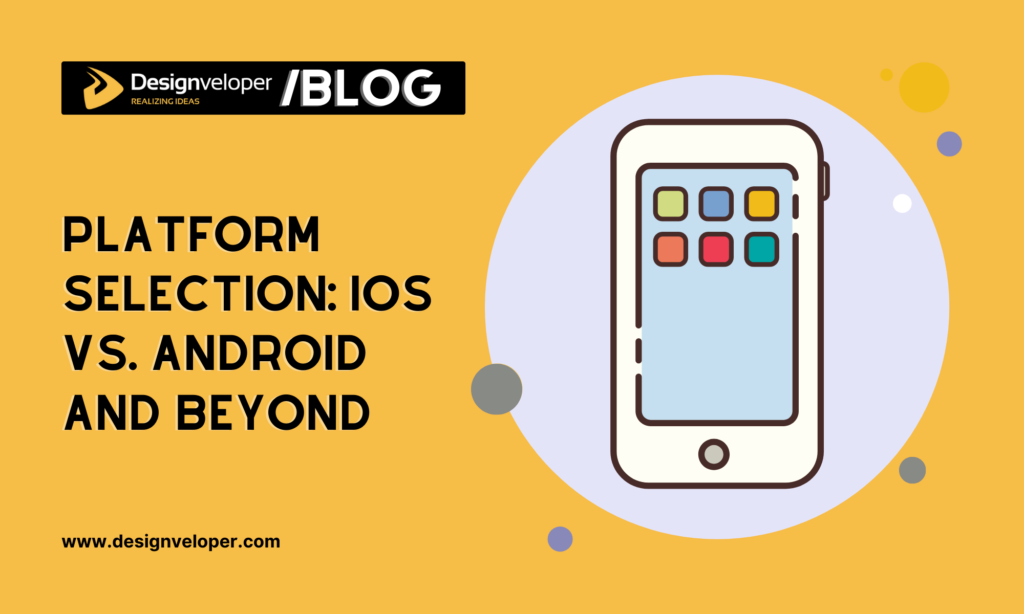
The platform selection is an extension of your app research. Mobile app research findings help you not only identify the right development direction for your app but also choose the right platform to reach its full potential. But why does platform selection matter? And what are the key considerations in selecting a platform? Read on to find the answers.
Why Choose the Right Mobile App Platforms?
The platform you choose determines the reach of your app. Each platform comes with its own demographic characteristics, and understanding these can help you tailor your app to your target audience. Moreover, different platforms support different features and have varying development costs and timelines. Therefore, choosing the right platform is crucial for maximizing your reach, minimizing your risks, and setting your app up for success.
Factors to Consider
When selecting a platform, consider the following factors:
Target Audience: Where are your ideal users hanging out? Do they dominate the iOS ecosystem or rule the Android kingdom? Understanding their platform preferences is key to helping you identify which platforms they use the most.
App Features: Does your app require specific functionalities or advanced capabilities? Some platforms, like iOS, are known for their high-end features, while others, like KaiOS, cater to simpler devices. Not to mention some features may only be available on certain platforms. So, make sure the platform you choose supports all the features you want to include in your app.
Budget and Development Time: Building for multiple platforms can be a resource-hungry beast. Consider your budget and development timeline to choose the platform that delivers the most impact on your investment.
Choosing Your Launchpad: Android vs. iOS and the Niche Alternatives
Android and iOS are the two major players in the mobile app market. Android, with a market share of over 70%, is the most widely used mobile operating system. Its open-source nature allows for high customization, but this can also lead to fragmentation and security issues.
On the other hand, iOS, with a market share of nearly 30%, is known for its uniformity across devices and its stringent app review process, which enhances security and user experience but can also lengthen the app approval time.
While iOS and Android dominate the market, niche platforms like Samsung’s Tizen, KaiOS, Windows, and Linux also exist. These platforms may not have as wide a reach as Android or iOS, but they cater to specific audiences and can offer unique benefits. For instance, KaiOS is popular in emerging markets, and Linux is favored for its open-source nature. Exploring these platforms could open up new opportunities for your app.
However, the ideal platform isn’t always a single choice. Consider a hybrid approach, leveraging cross-platform development tools to reach a wider audience while maintaining a native feel.
Top 3 Emerging Technologies in Mobile App Market Research
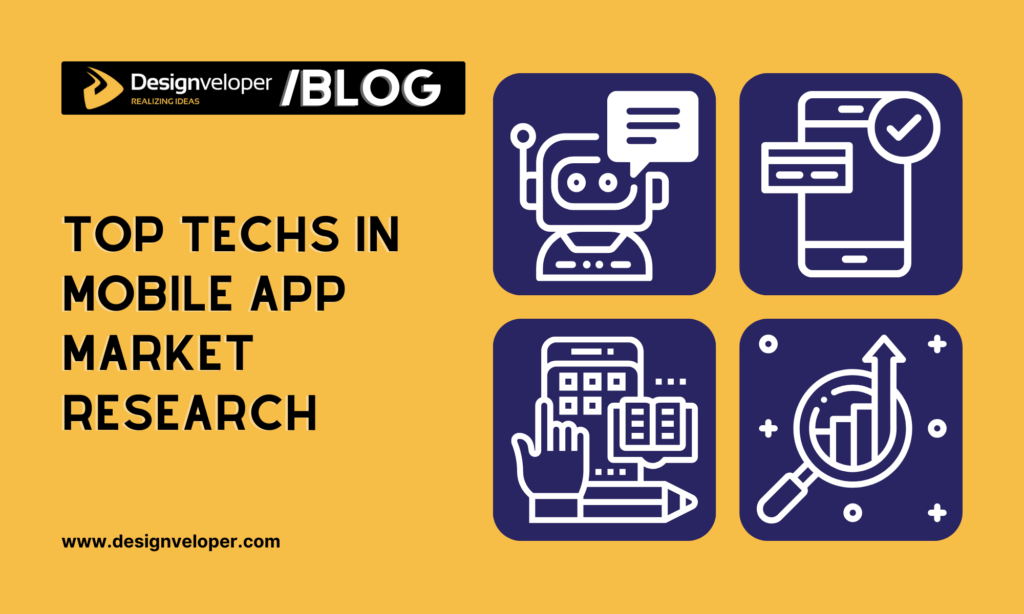
Technology is transforming the landscape of mobile app research. Tech-based solutions offer quicker and more affordable insights at a larger scale. Therefore, they’re increasingly being adopted by organizations, replacing traditional research methodologies. In this section, let’s explore the top four emerging technologies together.
Artificial Intelligence (AI) Integration
AI is increasingly becoming a cornerstone in the field of market research. A significant 80% of industry professionals believe that AI will have a positive impact on market research, primarily due to its potential to enhance data quality. Furthermore, 75% of researchers predict that the data generated through AI will surpass today’s accuracy levels.
These statistics underscore the expanding role of AI in market research tasks. From sentiment analysis and predictive analysis to demand forecasting, AI integration is becoming more prevalent.
This trend is evident in the growing number of companies introducing AI-powered market research tools to support mobile app research. Tools such as SEMRush Market Explorer, Poll the People, AI Persona Builder, and Kompyte are just a few examples of how AI is being leveraged to revolutionize mobile app market research. These tools not only enhance the efficiency of data collection and analysis but also provide more accurate and actionable insights, paving the way for more informed decision-making in the mobile app market.
Social Listening Platforms
Social listening platforms are potent tools that monitor and analyze conversations and mentions related to specific topics on social media platforms. They aggregate social data and scrutinize it based on distinct attributes or metrics. These tools are a boon for mobile app market research, providing real-time feedback and insights from users.
The social listening landscape is constantly evolving, with new tools and vendors emerging to address specific needs and challenges. Looking ahead to 2024, nearly half of social intelligence professionals plan to focus on new social listening technology. While established players like Brandwatch, Sprinklr, or Talkwalker continue to dominate, the future holds exciting possibilities for even more sophisticated and targeted solutions.
Big Data Analytics
Big data signifies the enormous volume of both structured and unstructured data generated by various sources in our digital world, including social media, e-commerce transactions, and mobile devices. In 2021, it was reported that 46% of organizations utilized big data analytics as a research method.
The advent of big data is revolutionizing the approach to market research in several ways. Particularly, big data analytics, coupled with such advanced analytical techniques as AI/ML, provides access to a significantly larger and more diverse dataset. So you can generate a more accurate and in-depth perspective of consumer behavior and preferences on a scale that was previously unattainable.
Further, it enables you to conduct research in real-time, equipping brands with insights into consumer behavior and preferences as they occur.
With these outstanding benefits in market research, the potential of big data analytics continues to be harnessed further in the future.
Conclusion
Market research isn’t just for big companies, but also startups and SMEs! With this guide, you’ve unlocked the secrets to conducting effective market research for your mobile app project. Remember, the best apps solve real problems for real people. So, grab your phone, chat with your friends, and see what makes their lives tick. Use the tools we covered, from surveys to competitor analysis, to build a picture of your perfect user. Then, design an app that makes their day easier, brighter, or simply more fun.
Mobile app research is your superpower – use it to create something amazing, and remember, Designveloper is always here to help your app dreams take flight!












